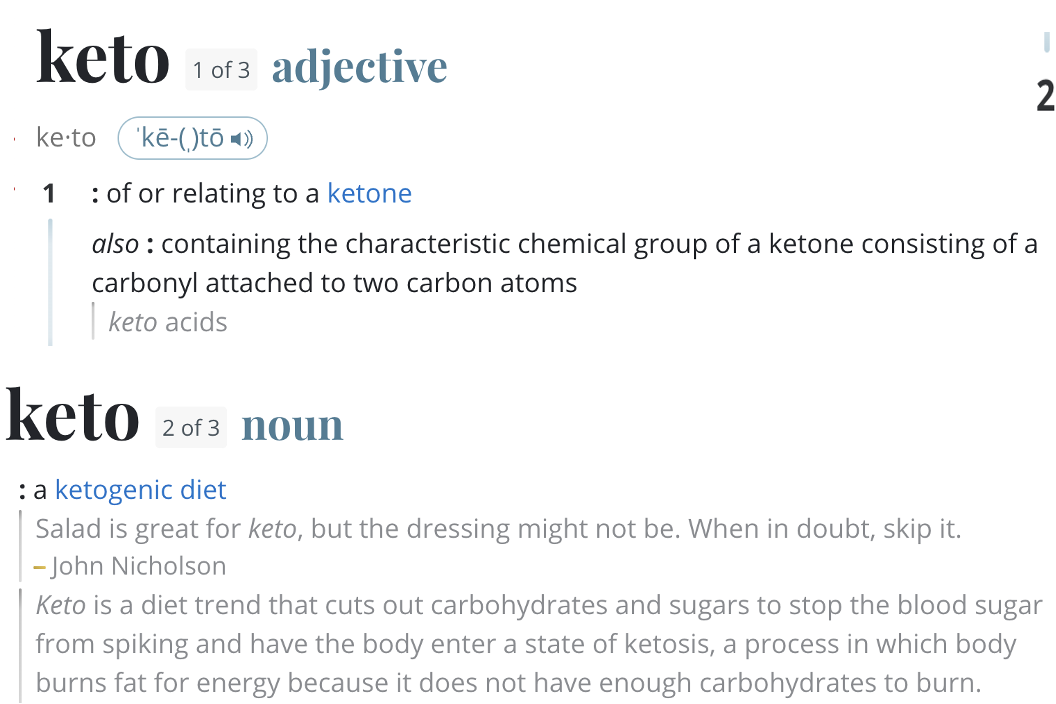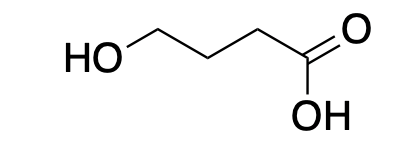
Go to Amazon and search for "keto." There are 10,000+ products, all of them foods and supplements to promote the keto diet. Madne$$.
Rarely does science get mangled as badly as when applied to diets. And it's impossible to discuss diets without focusing on the keto diet, a high-fat, low-carb regimen that is enormously popular, so much so that in 2020, “keto” was the most Googled food-related topic (globally), with 25.4 million searches. I'm guessing that few of those who did those searches fully understand the term, and you may or may not by the time you finish this hideous article – a huge assumption.
Let's start with Miriam-Webster.



Quelle pagaill! Source: Miriam-Webster dictionary
In case that's not bad enough, consider the following:
- The term "keto" comes straight from organic chemistry – like many medical terms – specifically the term "ketone" (see Figure 1), which gets maimed by diet fanatics and supplement sellers.
- The "keto" in the "keto diet" is an abbreviation of ketone, a common class of organic compounds.
- But people who practice the keto diet don't eat ketones, as the name may suggest to some.
- Keto is also short for ketogenic– the production of three specific ketones (aka ketone bodies, (1)) synthesized by the body metabolizing fatty acids. It is also short for ketosis, the production of ketone bodies from fatty acids.
- But this is only partly correct. Three ketone bodies are produced by fat metabolism, but only two are actually ketones (Figure 1); the third compound, beta-hydroxybutyric acid, is called a ketone, but it's not.
- This kind of thing happens when biologists and physicians try to name chemicals.
- I wasn't kidding about this stuff being confusing.
Put down sharp objects. I'll try to make sense of this. But this involves a little chemistry (as if this is gonna make things less confusing)
The three "ketone bodies" formed when fat is metabolized (especially in the absence of carbohydrates) are acetone, acetoacetic acid, and beta-hydroxybutyric acid, all very simple molecules. Except that's wrong. (Figure 1)

Figure 1 - "Ketone bodies." (Left) A ketone is a carbonyl group (carbon double bonded to oxygen (red circle) flanked by alkyl groups, e.g., methyl, ethyl, propyl... Acetone is the simplest ketone. (Center) Acetoacetic acid is one of the two acidic ketone bodies (because of its carboxylic acid group). (Right) Beta-hydroxybutyric acid is the other, even though it is not a ketone.
Quiz: A simple isomer of beta-hydroxybutyric acid is a dangerous drug. What is it? (Answer below)
Clarification plus more confusion
Acetone, which is one of the chemicals used in nail polish remover, is responsible for "keto breath." The lungs excrete the acetone produced by the body, so brushing your teeth won't get rid of the smell. (The same holds true for "garlic breath," something which I discussed in 2023.) Although acetone is called a ketone body, it is not acidic.
Acetoacetetic acid is a key molecule that the body uses to provide energy to tissues, especially during periods of low carbohydrate intake. Although glucose is the brain's primary fuel, acetoacetic acid can step in when glucose levels are low. Acetoacetetic acid is the only ketoacid formed during ketosis. This just seems wrong.
Beta-hydroxybutyric acid, like acetoacetic acid, plays a critical role in the body's ability to adapt to low carbohydrate environments by serving as an alternative energy source for the brain, but also for the muscles, and heart. Slight problem: It's not a ketone, as shown in Figure 1.
Bottom line: If you're still conscious...
- The keto diet is based on the change in energy generation when carbohydrates are absent, and the body burns (metabolizes) fat instead.
- During this process, three "acidic" ketone bodies are formed
- "Ketone bodies" is a stupid term. They are chemicals, not life forms.
- And only two of them are acidic.
- Of the three "acidic" ketones formed during the keto diet, only two are ketones.
Congrats!
If you made it through this horror show, go get a pack of Twinkies. They're not keto, and maybe not even food.
NOTE:
(1) IMO ketone bodies is a confusing and antiquated term, which should not be surprising since it was coined in the 19th century, around the same time that Henry Miller was in medical school.
Quiz answer: Gamma-hydroxybutyric acid, where the hydroxyl group is at the end of the 4-carbon chain, is also called GHB. It is one of the date rape drugs.

gamma-Hydroxybutyric acid, aka GHB



